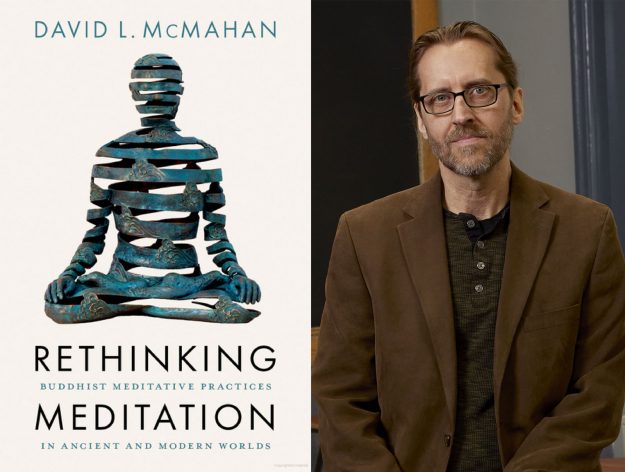Strawberries and the Ethic of Appreciation
A well-known Buddhist story, and its contemporary interpretations, reveal the evolving tension between ascetic detachment and compassionate engagement—and where meditation fits in. The post Strawberries and the Ethic of Appreciation appeared first on Tricycle: The Buddhist Review.

A man traveling across a field encountered a tiger. He fled, the tiger after him. Coming to a precipice, he caught hold of the root of a wild vine and swung himself down over the edge. The tiger sniffed at him from above. Trembling, the man looked down to where, far below, another tiger was waiting to eat him. Only the vine sustained him. Two mice, one white and one black, little by little started to gnaw away the vine. The man saw a luscious strawberry near him. Grasping the vine with one hand, he plucked the strawberry with the other. How sweet it tasted!
This well-known story is from one of the first widely read works on Zen published in English, Zen Flesh, Zen Bones, compiled and published by Paul Reps in 1957. It incorporates stories from several sources, including a book published in 1919 called 101 Zen Stories, which in turn drew mostly from a 13th-century Japanese collection, the Shasekishū, and a koan collection, The Gateless Gate (Jpn: Mumonkan).
Ask anyone today the meaning of the story and they will likely give the same answer: carpe diem; Seize the day! Enjoy life while it lasts; live life to the fullest; savor the simple pleasures of life while you can; or, in the words of the title of a book by Maezumi Roshi: Appreciate Your Life. Many philosophers and religious thinkers have emphasized that profound awareness of one’s mortality changes the way one lives and feels life. Anyone who has had a serious illness or accident knows something about this. So this story presents an illustration of being able to appreciate the sweetness of whatever the moment brings in the face of the situation we are all inevitably in—hanging on for life while the white and black mice of passing days and nights nibble away at our remaining time. The Zen attitude, the story suggests, is to fully appreciate and savor each moment in unblinking awareness of our precarious circumstances. Meditation, we might further infer, fosters this appreciation.
There exist, however, other iterations of the story that imply an altogether different message, including versions in ancient Buddhist and Hindu texts. The Buddhist one is in the Lalitavistara, a fourth-century account of the life of the Buddha. In this text, the man is chased by an elephant instead of a tiger, he falls into a well instead of off a cliff, and rats, rather than mice, nibble the vine. Below him is a great serpent, and four snakes come from the sides of the well attempting to bite him. Instead of the strawberry, there is a beehive from which drops of honey fall into his mouth while bees swarm and sting him. And brush fires burn the tree branch to which he clings. The Buddha, who is relating this story, details what the various elements represent (the elephant is impermanence, the fire is old age, the serpent below, death). The five drops of honey represent desires for food and drink, sleep, sex, wealth, and fame. He leaves no ambiguity about the moral of the story: “That is why, great king, you should know that birth, old age, illness, and death are quite terrible. You should always remember them, and not become a slave to your desires.” In a version found in the Hindu epic, the Mahabharata, the story is put into the mouth of a Jain monk, who explains that the drops of honey are trivial pleasures that people become attached to and consume insatiably, distracting them from the spiritual life. He mocks the doomed man for craving the superficial pleasure of the honey in the face of his precarious situation.
The story of how this tale migrates from the world-weary ethos of ancient ascetic communities in India to the back pockets of world-affirming, strawberry-eating seekers in the 1960s is long, complicated, and fascinating. The story of the Buddha’s life told in the Lalitavistara, containing within it our story of the unfortunate falling man, was picked up by the Manicheans and transformed into the tale of Barlaam and Josaphat (the latter’s name is likely derived from the term “bodhisattva”). An Arabic version circulated in eighth-century Persia, and from there it was adapted to Christianity and attributed to St. John Chrysorrhoas of Damascus (675–749). In this version the man is transfixed with tasting the honey and, failing to notice a ladder his friend extends to him, falls and is devoured by the dragon below, now representing Satan.
The story of Barlaam and Josaphat circulated throughout Europe and the Middle East for centuries and was translated into many languages. In the nineteenth century, Leo Tolstoy used the story of the man in the well as the centerpiece of his autobiographical work, A Confession, where he saw it as an expression of the futility of his life up to the point of his radical personal transformation and embracing of a liberal, pacifist understanding of the teachings of Jesus. Tolstoy’s autobiography, in turn, had a profound influence on a young Indian lawyer in the nineteenth century—Mohandas Gandhi—who would incorporate it into his own revolutionary teachings. So the story made its way back to India after becoming a part of most of the major religious traditions of the world and attaining new meanings and significance in each one. Meanwhile, around the same time Gandhi encountered it, a Zen monk named Nyogen Senzaki (1876–1958), one of the first Zen monks to teach in the United States, compiled and helped translate a version of the story of the man in the well—which had all the while been circulating in Asia, both independently and as a part of the Lalitavistara and other texts—into the version we have now in English in the book 101 Zen Stories, which became a part of Reps’ slim, pocket-sized volume, which is still in print and part of essential Zen reading in America.
The journey of this story illustrates how texts, works of art, poems, rituals are never fixed in their meaning. They yield up new interpretations in new contexts, as novel meanings are coaxed out of them by new cultural contexts, and people tweak them to resonate with prevailing ideals and assumptions. All of this is a rather roundabout way of illustrating that the ethic of renunciation so pervasive in early Buddhist literature often fades into invisibility in modernized Buddhisms and is largely displaced by what I would call the ethic of appreciation. This ethic entails an affirmation of the implicit value of the physical world, the senses, and the ordinary experience of ordinary people. The ethic of appreciation contrasts strikingly with the ethic of world-renunciation that dominates the early Buddhist literature. It is part of a broader Indian ascetic literature that attempts to train the mind to see things in particular ways, develop particular virtues, sensibilities, aesthetic responses, and affective habits. According to the suttas and the Vinaya, monastics must train themselves in detachment from the world. They are to cultivate indifference, for example, to the eight worldly concerns: hope for gain and fear of loss; hope for fame and fear of disgrace; hope for praise and fear of blame; hope for pleasure and fear of pain (AN 8.5). They are to see the world as something that cannot possibly bring about satisfaction, as something fleeting and unreliable, deceptive and beguiling. They should become disenchanted with it and withdraw emotional investment in seeking satisfaction from it. They are to imagine the interior of bodies to counter attraction to physical beauty, cultivate revulsion at physiological processes like digestion and sex, and take opportunities to view corpses to ameliorate illusions of permanence and vivify the inevitability of death. They are to shun attachment to family and avoid seeking solace in the inevitably fragile and unstable human relationships. The world is often called a “mass of suffering.”
There is another side to this, however. These attitudes exist in counterpoint to advice in the suttas on good family relations and the need to cultivate particular social emotions like love, compassion, and taking joy in others’ happiness. In some literature, readers are advised to cultivate the kind of love toward all living beings that a mother has for her only son. The Buddha gives advice to kings on worldly affairs and is clearly invested in the wellbeing of people, animals, and society. So throughout the Buddhist traditions a tension exists between an ethic of detachment and renunciation and a more this-worldly ethic of compassion and engagement. Also, we should remember the wide array of this-worldly practices Buddhists have developed that were oriented toward physical health, worldly prosperity, and a fortunate rebirth this side of nirvana. We have to be careful, therefore, not to overstate the anti-worldliness of early Buddhism or suggest that it has an unrelentingly negative view on embodied life. Rather, a great deal of Buddhist literature attempts to navigate this tension between ascetic detachment and compassionate engagement.
The message of the early version of the story of the man in the well—as well as the meditations on corpses and contemplations of the repugnance of the body—is not that one should appreciate one’s life, with its delicious honey drops, beautiful scenery, exquisite scents and tastes, and other physical delights. It is, rather, that such sensual engagement merely entraps one further in the cycle of samsara. Granted, Buddhist traditions are not univocal in this. Tantric literature sometimes starkly reverses the devaluation of the physical, valorizing the body and physiological processes, seeing them as essential to liberation. A passage from the Candamaharosana Tantra, for example, declares:
One should not torment oneself with austerities,
Abandoning the five sense-objects.
One should notice beauty as it comes along,
And listen to the sound.
One should smell the odor
And savor the supreme taste.
One should experience the sensation of touch,
Pursuing the five types of sense-objects.
One will quickly become awakened….
East Asian Buddhist literature, drawing from the broader strains of the Daoist reverence of mountains, rivers, and trees, expresses a similar admiration of the physical and natural world, some seeing even rocks and grasses as infused with buddha-nature.
The ethic of appreciation that has more recently become intertwined with Buddhist and Buddhist-derived meditative practices, however, may be something new. It is part of the modern valorization of worldly life, what the philosopher Charles Taylor calls the “affirmation of ordinary life.” The idea is that the value and dignity of human life does not reside beyond it but in the manner of living it. The ordinary person, rather than the noble warrior or king, becomes the center of artistic attention in modern art and literature, where ordinary experience is valorized and, in some cases, even sacralized. Much of the world of global, cosmopolitan late-modernity flows from the European Enlightenment, and one of its distinctive characteristics was this broad sense of world-affirmation. Most inheritors of this tradition have a general sense that the world and worldly activity are good in and of themselves. Marriage, reproduction, and work attain an esteem absent in medieval times, when the world was often considered a place of brief, temporary residence prior to occupying one’s true home in the afterlife. Pleasure was positively reevaluated, as was material well being. A positive view of the prospects of worldly satisfaction is not, of course, exclusive to the modern West, but it has been a prominent and enduring feature of the modern and late-modern eras.
Contemporary meditation and mindfulness practices have embedded themselves in this world-affirming ethos, absorbing it so thoroughly as to transform the significance of the practice itself. Consider a standard exercise in Mindfulness-Based Stress Reduction courses. One of the first things students do is eat a raisin. They first look at the raisin, notice its folds and contours, then eat it excruciatingly slowly, with complete focus on the flavors, sensations, textures—all the nuances of the experience of this simple, everyday activity. The exercise is designed to bring increased attention to something familiar in order to uncover hidden dimensions of ordinary experience. The clear implication is that all experiences are like this. They all contain hidden aspects, secret delights, normally occluded subtleties to which we, in our mindless routines, have become blind. To increase attention to the fine-grained qualities of our ordinary experiences is to truly live our life rather than miss it in a haze of daydreams, distractions, and mental chatter. The underlying message is: the raisin is good; your sense-experience is good; your life as an embodied being who eats and digests and has sex and enjoys the sights, sounds, tastes, sensations, and smells of the natural world is good.
The purpose of close attention to the ordinary phenomena of embodied experience in the early Buddhist meditation texts is quite different. These practices are designed to bring about disenchantment (nibbida—sometimes translated “revulsion”) with all phenomena and to develop dispassion (viraga) and detachment from them. There is still a hint of detachment in contemporary versions: one detaches from one’s ordinary habitual attitudes and mindless sleepwalking through life in order to discover the hidden treasures just below the surface. And it is not just treasures: sometimes one finds ugly emotions, hidden internal conflicts, repressed desires. But underlying it all is the idea that in order to deal with such difficulties, as well as appreciate the wonders of life, one must be mindful and increase one’s scope of awareness—and that, ultimately, even in the face of old age, sickness, and death, embodied human life is good in and of itself, whether or not there is an afterlife or nirvana.
The point here is not to disparage recent reconfigurations of meditation as not sufficiently “traditional,” nor to laud them as having shaken off the shackles of tradition. Buddhist traditions have been adapted and transformed in different cultures long before coming to the West. In each case, the ideas and practices incorporated elements of the new culture and, in turn, contributed to changes in those cultures. In each case at least part of the value that meditative practices have offered derived not from the fact that they are being practiced exactly as a preceding historical version of the tradition practiced it but in how they became relevant in a novel cultural context.
If the ethic of appreciation is baked into contemporary culture, and meditation and mindfulness in our era are inevitably tilted toward the “this-worldly” side of the equation, the question then becomes: to what this-worldly uses are these practices best put today? Is meditation a tool for creating more productive workers to feed the system of global capital? Or does it focus the critical faculties of the mind for resistance against systems of routinization, commodification, and oppression? For critical inquiry into the social hierarchies and oppressive structures? Does it create an inner citadel that insulates one from being adversely affected by external events? Or does it create greater attunement, intimacy, and sensitivity to the world and others in the world? Is it for creating mental and physical health as understood today? Or for fostering an awareness of a transcendent dimension of experience? These are questions that, whether they are formulated explicitly or not, are being worked out among practitioners and their communities every day. They are not so much about the abstract question how does meditation work? but, rather, what work does meditation do in a novel cultural ecosystem?
♦
 Author photo by Eric McNatt
Author photo by Eric McNattThis piece is adapted from the forthcoming book Rethinking Meditation: Buddhist Meditative Practices in Ancient and Modern Worlds, Oxford University Press.

 Tekef
Tekef 
































